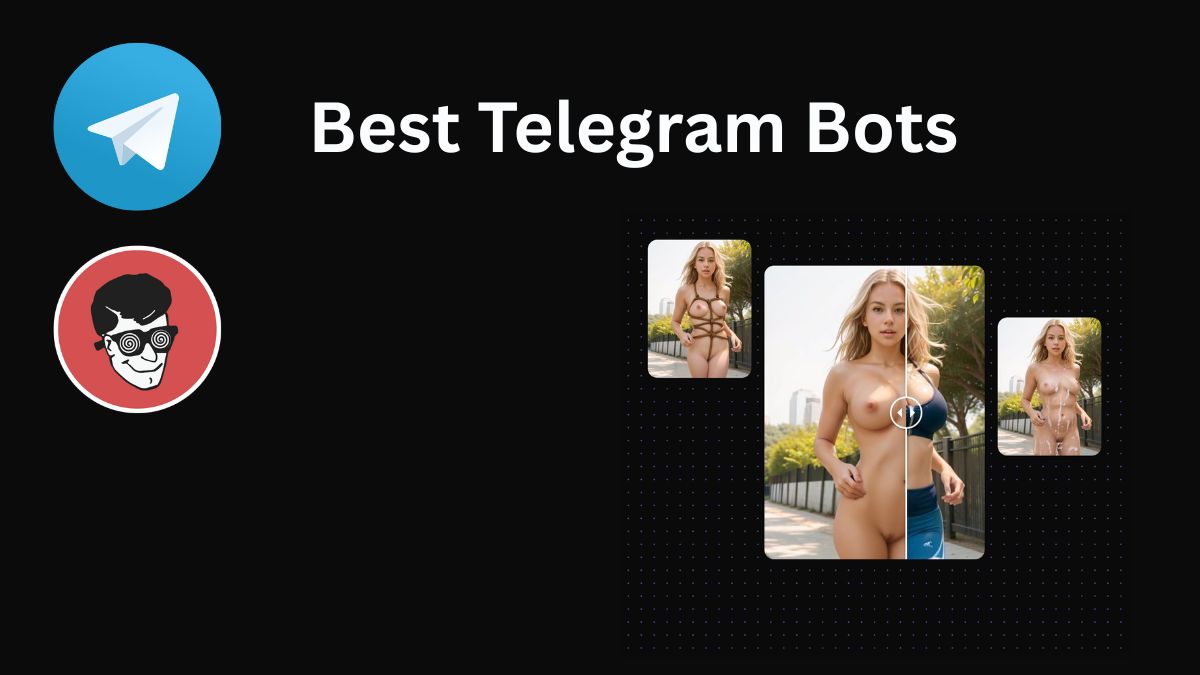This is the list of apps I was able to find and identify.
- @OKbra Bot – Nude bot to try with 53 Options (2 Free and 51 Paid).
- ShirtUp Video Bot – Undress your girl by one Photo. 1 Free.
- @NuBee_Bot – Very fast – 16 sec. Really good bot. Has 2 Free tries.
- @ClothOff – Good bot. But free only with blur.
- DeepFake Bots – 1 free photo each 2 days. Ban-resistant.
- Bra Undress Bot – Freemium. But has only 1 Free try. Daily lottery.
- @UndressHer – 25 Free Tokens. Rapid Bot!
- Mad Journey Bot – has only 1 Free try and it works quickly!
- Lisa-AI – Fast and reliable AI image processing bot with high quality results.
- ClothisOFF7_bot – 10 Free Undress, Queue >1 hour. Women and Men.
- @succubus_images_bot – Bot generating an free image NSFW or SFW. Low quality.
- UnderXAI Bot
- Deep AI Pro Bot
- @St_diffusion_bot
- TPL Bot
- LustraTOP – Undress Bot.
- @Undress X bot – is a fast and high-quality bot. Banned.
- @Fastbot – There are no limits. Really fast Telegram bot. Banned.
- SoulGen bot – the well-known service has launched its own bot and cloned it. (same Crazythursdaybot)
- Mad Journey Bot – Get 2 Free tokens = 2 photo.
- Pure Naked Bot – Freemium. But has only 1 Free drawing opportunity.
- Nudify-Me – Get 2 Free Generations. A+ result! Drawing option.
- Nangefake Bot – New! No free, but many options.
- Nudify.me Bot – 1 Free or paid $4.99/ 5 credits. Ban-resistant.
- @AIphotolab – another bot with 4 free tries.
- InsOff Bot – Need to Try! 2 Free.
- Nudify_bot – very-slow bot but has 2 VIP +20 Regular Coins for Free (men or women).
- @Momo Bot – 10 Free Photos.
- AI-Draw – very fast bot! Must to try! 10 tokens for free ~ 3-4 Generations.
- @NudifyIT – 5 Free Tries! Slow Tg Bot but good quality! Banned.
- CloLess – one of good deepnude bots. You will have 2 free attempts. The result of the generation tends to be realistic, which is good, but it also has small defects.
- @Nudifier – 2 Free but very SLOW! Do not Recommend!
- @Swapoo – Free, but too many bugs and @SnapDress – little-slow bot but has 1 Free try.
- @AIPiPi_bot (ex PPNude Bot) – high-quality, fast (up to 60 seconds in the queue). Migrate from Bot to Web App.
- @Unveil bot – Good bot. Free 1, only with blur.
- @NudeMe-bot – the owner steals your credits.
Why I put together this list is to show you how huge a problem the availability of unsafe AI applications is.
Key Insights on Undress AI Technologies
- Advancements in Diffusion Model Architecture: Modern Undress AI and deepfake tools are built on architectures like Stable Diffusion XL, enhanced by innovations such as ControlNet and LoRA fine-tuning. These enable precise editing of specific image elements (e.g., clothing, anatomy) while preserving the original structure, balancing photorealism with targeted manipulation.
- Detection and Traceability Solutions: Cutting-edge detection systems, including C2PA for content provenance and AI classifiers like GLAZE and SynthID, now identify synthetic media with high accuracy. Embedded metadata and cryptographic watermarks (e.g., Google’s Content Credentials) ensure traceability even after edits, compression, or format shifts.
- Inherent Safety in AI Model Design: State-of-the-art LLMs such as GPT-4o, Claude 3, and Llama 3 incorporate reinforcement learning from human feedback (RLHF) and value-aligned training datasets to block malicious requests. Multi-stage content filters and ethical guardrails prevent the generation of non-consensual imagery at both input and output levels.
- Proactive Image Protection Tools: Frameworks like UnlearnDiff (Meta) and DiffPure (HuggingFace) apply AI-specific “vaccinations” to images—adding microscopic noise patterns that destabilize manipulation algorithms without affecting human perception. This adversarial defense disrupts undress AI workflows while maintaining visual integrity.
- Global Regulatory Shifts: The EU’s Digital Services Act and UK’s Online Safety Act now mandate strict accountability for synthetic media, requiring developers to implement audit trails, risk assessments, and real-time content labeling. These laws enforce technical compliance, such as immutable metadata and platform-level detection integration, reshaping development priorities.
How do they work?
Their principle is very simple: you upload a photo of a girl or a guy, or several friends. The algorithms analyze the image and generate a new one, but fake and without clothes. This is fake nudity with the help of AI.

Ethical & Legal Concerns
- Privacy Breaches: Unauthorized clothing removal is a direct violation of personal rights.
- Non-Consensual Pornography: Classified as sexual exploitation in multiple jurisdictions.
- Potential for Harassment: Tools can facilitate doxing, blackmail, or social humiliation.
- Legal Actions: Courts in various regions (e.g., California in 2024) have prosecuted operators of “undressing” websites.
Resources and References
Technical Papers and Research
- Wang, X. et al. (2024). Detecting Diffusion Model Manipulation: Current Methods and Limitations
Comprehensive analysis of detection techniques for identifying AI-manipulated content. - Zellers, R. et al. (2023). Adversarial Immunization: Making Images Resistant to AI Manipulation
Novel techniques for protecting images from unauthorized AI manipulation.
Technical Documentation and Standards
- C2PA (2024). Technical Specification v1.4
Technical details for implementing content provenance in media assets. - Google DeepMind (2024). SynthID Technical Documentation
Implementation guidelines for Google’s watermarking system.
Development Resources
- HuggingFace (2025). Responsible AI Guidelines
Best practices for model development and deployment on the Hugging Face platform. - Partnership on AI (2024). Synthetic Media Development Framework
Technical and ethical guidelines for developing synthetic media technologies.
Safety Tools and Implementations
- Meta AI (2024). Content Authentication Framework
Open-source tools for detecting and authenticating AI-generated content. - OpenAI (2025). Safety Evaluations: Technical Methodologies
Detailed explanation of OpenAI’s technical approach to model safety.
Legal and Regulatory Resources
- EU Commission (2024). Technical Standards for AI Act Compliance
Technical implementation guidelines for meeting EU AI Act requirements. - UK Digital Regulation Cooperation Forum (2024). Online Safety Act: Technical Briefing
Technical details of UK regulatory requirements for AI systems. - Complete list of all bots with detailed descriptions (2025) https://deepnudetelegram.com/


Leave a Reply